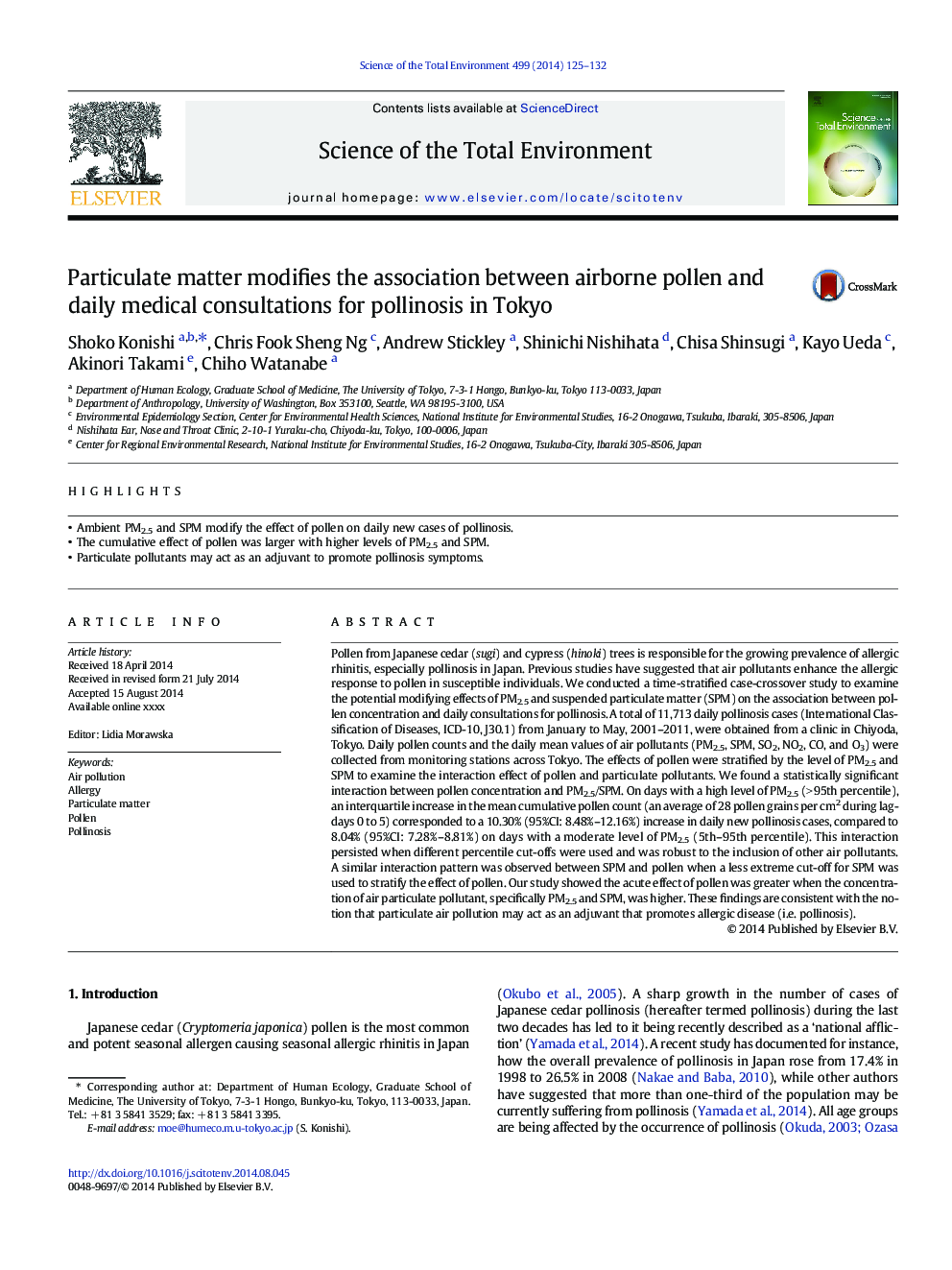| کد مقاله | کد نشریه | سال انتشار | مقاله انگلیسی | نسخه تمام متن |
|---|---|---|---|---|
| 6328876 | 1619774 | 2014 | 8 صفحه PDF | دانلود رایگان |
عنوان انگلیسی مقاله ISI
Particulate matter modifies the association between airborne pollen and daily medical consultations for pollinosis in Tokyo
ترجمه فارسی عنوان
ماده تیتانیوم، ارتباط بین گرده هوا و مشاوره های روزانه پزشکی برای بالون را در توکیو تغییر می دهد
دانلود مقاله + سفارش ترجمه
دانلود مقاله ISI انگلیسی
رایگان برای ایرانیان
کلمات کلیدی
آلودگی هوا، آلرژی، ذرات جامد، گرده، پولینوزیس،
موضوعات مرتبط
علوم زیستی و بیوفناوری
علوم محیط زیست
شیمی زیست محیطی
چکیده انگلیسی
Pollen from Japanese cedar (sugi) and cypress (hinoki) trees is responsible for the growing prevalence of allergic rhinitis, especially pollinosis in Japan. Previous studies have suggested that air pollutants enhance the allergic response to pollen in susceptible individuals. We conducted a time-stratified case-crossover study to examine the potential modifying effects of PM2.5 and suspended particulate matter (SPM) on the association between pollen concentration and daily consultations for pollinosis. A total of 11,713 daily pollinosis cases (International Classification of Diseases, ICD-10, J30.1) from January to May, 2001-2011, were obtained from a clinic in Chiyoda, Tokyo. Daily pollen counts and the daily mean values of air pollutants (PM2.5, SPM, SO2, NO2, CO, and O3) were collected from monitoring stations across Tokyo. The effects of pollen were stratified by the level of PM2.5 and SPM to examine the interaction effect of pollen and particulate pollutants. We found a statistically significant interaction between pollen concentration and PM2.5/SPM. On days with a high level of PM2.5 (>Â 95th percentile), an interquartile increase in the mean cumulative pollen count (an average of 28 pollen grains per cm2 during lag-days 0 to 5) corresponded to a 10.30% (95%CI: 8.48%-12.16%) increase in daily new pollinosis cases, compared to 8.04% (95%CI: 7.28%-8.81%) on days with a moderate level of PM2.5 (5th-95th percentile). This interaction persisted when different percentile cut-offs were used and was robust to the inclusion of other air pollutants. A similar interaction pattern was observed between SPM and pollen when a less extreme cut-off for SPM was used to stratify the effect of pollen. Our study showed the acute effect of pollen was greater when the concentration of air particulate pollutant, specifically PM2.5 and SPM, was higher. These findings are consistent with the notion that particulate air pollution may act as an adjuvant that promotes allergic disease (i.e. pollinosis).
ناشر
Database: Elsevier - ScienceDirect (ساینس دایرکت)
Journal: Science of The Total Environment - Volume 499, 15 November 2014, Pages 125-132
Journal: Science of The Total Environment - Volume 499, 15 November 2014, Pages 125-132
نویسندگان
Shoko Konishi, Chris Fook Sheng Ng, Andrew Stickley, Shinichi Nishihata, Chisa Shinsugi, Kayo Ueda, Akinori Takami, Chiho Watanabe,
